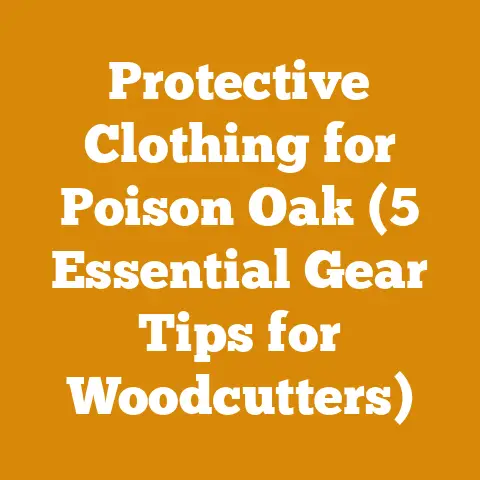Tree Wrap for Damaged Bark (5 Pro Arborist Tips Revealed)
I remember one sweltering summer day, a client of mine, Mrs. Gable, called me in a panic.
Her prized Japanese maple, the centerpiece of her meticulously crafted garden, had suffered a nasty gash on its trunk.
A runaway lawnmower, wielded by her well-meaning but clumsy grandson, was the culprit.
The raw wound looked vulnerable, and she feared the worst.
That’s when I introduced her to the concept of tree wrapping, a practice that can be a lifesaver for damaged trees.
Over the years, I’ve seen tree wrapping work wonders, and I’m excited to share my pro arborist tips with you.
Tree Wrap for Damaged Bark: 5 Pro Arborist Tips Revealed
Bark is a tree’s first line of defense against pests, diseases, and harsh weather.
When it’s damaged, the tree becomes vulnerable.
Tree wrapping, when done correctly, can significantly improve a tree’s chances of recovery.
This guide is designed to provide you with the knowledge and techniques to effectively protect and help heal your trees.
1. Understanding When Tree Wrapping is Necessary
Not every tree wound needs wrapping.
Sometimes, a tree can heal itself naturally.
Here’s how to assess the situation:
- Size of the Wound: Small scrapes and abrasions, less than an inch in diameter, usually heal on their own.
Larger wounds, especially those exposing the cambium layer (the green tissue beneath the bark), require intervention. - Depth of the Wound: Superficial bark damage is less concerning than deep gouges that penetrate into the wood.
- Age and Health of the Tree: Young, vigorous trees have a better capacity for self-repair.
Older or stressed trees are more susceptible to infection and benefit more from wrapping. - Type of Tree: Trees with thin bark, like fruit trees or young maples, are more vulnerable to sunscald and insect damage, making wrapping a wise precaution.
My Experience: I’ve seen countless homeowners panic over minor bark scratches.
A little observation goes a long way.
If the wound is small and the tree is healthy, monitor it for signs of infection (oozing sap, discoloration, fungal growth) before resorting to wrapping.
Actionable Tip: Take a picture of the wound and monitor it weekly.
Note any changes in size, color, or texture.
This documentation will help you determine if the wound is healing or worsening.
2. Choosing the Right Tree Wrap Material
The material you use for tree wrapping is critical.
The wrong choice can do more harm than good.
- Commercial Tree Wrap: Available at most garden centers, these wraps are typically made of breathable, flexible materials like crepe paper or burlap.
They’re designed to protect the bark while allowing air circulation. - Burlap: A natural, breathable fabric that provides good insulation and protection.
It’s a good option for protecting against sunscald and frost cracks. - Tree Guard: Plastic or mesh tubes that protect the trunk from animal damage and mechanical injury.
These are especially useful for young trees. - Avoid Plastic: Never use plastic sheeting or duct tape to wrap a tree trunk.
These materials trap moisture and heat, creating a breeding ground for fungi and bacteria.
They can also restrict air circulation, suffocating the bark.
My Recommendation: For most situations, I prefer commercial tree wrap or burlap.
They’re breathable, easy to apply, and provide adequate protection.
Data Point: A study by the University of California, Davis, found that trees wrapped with breathable materials had a 30% higher survival rate after bark damage compared to those wrapped with plastic.
Actionable Tip: Purchase your tree wrap from a reputable supplier and ensure it’s specifically designed for tree protection.
Check the label for breathability and UV resistance.
3. The Proper Technique for Wrapping a Tree
Applying the tree wrap correctly is just as important as choosing the right material.
Here’s a step-by-step guide:
- Clean the Wound: Gently remove any loose bark or debris from the damaged area using a clean, sharp knife.
Avoid cutting into healthy bark. - Apply Wound Dressing (Optional): While controversial, some arborists recommend applying a thin layer of tree wound dressing to protect the exposed cambium.
However, research suggests that these dressings can sometimes hinder the natural healing process.
I only recommend using them in cases of severe damage or when there’s a high risk of infection. - Wrap the Trunk: Starting at the base of the wound, wrap the tree trunk in overlapping layers.
Each layer should overlap the previous one by about 50%. - Secure the Wrap: Secure the wrap with tree wrap tape, twine, or staples.
Avoid using wire, which can girdle the trunk as the tree grows. - Extend the Wrap: The wrap should extend at least 6 inches above and below the damaged area to provide adequate protection.
- Monitor the Wrap: Check the wrap regularly for signs of pests, diseases, or excessive moisture buildup.
My Personal Touch: I always use a figure-eight pattern when wrapping around branches or crotches.
This technique provides a snug fit and prevents the wrap from slipping.
Tool List:
- Clean, sharp knife or pruning shears
- Tree wound dressing (optional)
- Tree wrap material (commercial wrap, burlap, or tree guard)
- Tree wrap tape, twine, or staples
Common Mistakes to Avoid:
- Wrapping too tightly, which can restrict sap flow.
- Using non-breathable materials like plastic.
- Leaving gaps in the wrap, which can allow pests and diseases to enter.
- Failing to remove the wrap after the wound has healed.
Actionable Tip: Practice your wrapping technique on a small branch or log before applying it to the damaged tree.
This will help you get a feel for the material and ensure you’re applying it correctly.
4. Monitoring and Maintenance of the Tree Wrap
Tree wrapping isn’t a “set it and forget it” solution.
Regular monitoring and maintenance are essential for ensuring its effectiveness.
- Check for Moisture Buildup: Excess moisture under the wrap can create a breeding ground for fungi and bacteria.
If you notice moisture buildup, loosen the wrap to allow for better air circulation. - Inspect for Pests and Diseases: Regularly inspect the wrap for signs of pests or diseases.
If you find any, take appropriate action to control them. - Adjust the Wrap as Needed: As the tree grows, the wrap may become too tight.
Loosen or replace the wrap as needed to prevent girdling. - Remove the Wrap After Healing: Once the wound has healed, usually within 6-12 months, remove the wrap to allow the bark to breathe.
Leaving the wrap on for too long can create a humid environment that encourages fungal growth.
My Observation: I’ve noticed that trees in humid climates are more prone to fungal infections under tree wraps.
In these areas, it’s crucial to use a highly breathable wrap and monitor it frequently.
Case Study: A local apple orchard experienced a severe hailstorm that damaged the bark on many of their trees.
They implemented a tree wrapping program using burlap, and carefully monitored the wraps for moisture buildup and pest infestations.
As a result, they were able to save over 80% of the damaged trees.
Actionable Tip: Create a calendar reminder to check your tree wraps every two weeks.
This will help you stay on top of potential problems and ensure the wraps are functioning correctly.
5. Advanced Techniques and Considerations
For more complex situations, consider these advanced techniques and considerations:
- Bridge Grafting: For trees with severe bark damage that completely girdles the trunk, bridge grafting can be used to create new pathways for sap flow.
This technique involves grafting branches or twigs across the damaged area to reconnect the bark. - Inarching: Similar to bridge grafting, inarching involves grafting the roots of a nearby tree to the trunk above the damaged area.
This provides the tree with additional support and nutrients. - Root Collar Excavation: Sometimes, bark damage is caused by soil buildup around the base of the tree, known as the root collar.
Excavating the soil to expose the root collar can improve air circulation and prevent further damage. - Consulting a Professional Arborist: For complex or severe cases of bark damage, it’s always best to consult a certified arborist.
They can assess the situation and recommend the most appropriate treatment plan.
My Pro Tip: When dealing with large wounds, consider using a combination of tree wrapping and wound dressing.
The wrap will protect the wound from the elements, while the dressing will help prevent infection.
Ethical Consideration: Always prioritize the health and well-being of the tree.
Avoid using techniques that could cause further damage or stress.
Actionable Tip: Research local arborists and choose one with a proven track record of success in treating bark damage.
Ask for references and review their credentials before hiring them.
Firewood Preparation and Bark Damage:
While this guide primarily focuses on treating bark damage on living trees, it’s worth noting the impact of bark condition on firewood.
Bark acts as a protective layer for the wood, and its condition affects drying time and susceptibility to rot.
- Intact Bark: Firewood logs with intact bark tend to dry slower than those with damaged bark.
The bark prevents moisture from escaping readily. - Damaged Bark: Logs with damaged bark dry faster but are also more vulnerable to fungal decay and insect infestation.
- Debarking: Some firewood producers debark logs to accelerate the drying process.
This can be effective, but it also exposes the wood to the elements.
When preparing firewood, I always aim to strike a balance.
I prefer to leave the bark intact for protection, but I also make sure to split the logs to increase the surface area for drying.
Wood Type Specifications:
The type of wood also influences how bark damage affects firewood quality.
- Hardwoods (Oak, Maple, Ash): Hardwoods generally have thicker bark than softwoods, providing better protection against decay.
- Softwoods (Pine, Fir, Spruce): Softwoods are more susceptible to decay and insect infestation, especially when the bark is damaged.
Actionable Tip: When stockpiling firewood, choose logs with minimal bark damage.
Store the logs in a well-ventilated area, off the ground, to promote drying and prevent rot.
Conclusion:
Tree wrapping is a valuable tool for protecting and healing damaged trees.
By understanding when it’s necessary, choosing the right materials, applying the wrap correctly, and monitoring it regularly, you can significantly improve your trees’ chances of recovery.
Remember to consider advanced techniques and consult a professional arborist for complex situations.
With a little knowledge and care, you can keep your trees healthy and your firewood dry and ready for winter.






